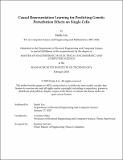Causal Representation Learning for Predicting Genetic Perturbation Effects on Single Cells
Author(s)
Liu, Emily
DownloadThesis PDF (4.993Mb)
Advisor
Uhler, Caroline
Terms of use
Metadata
Show full item recordAbstract
Advances in sequencing technologies have significantly deepened our understanding of gene regulation in cells. Among these, Perturb-seq has emerged as a powerful technique, enabling high-resolution profiling of transcriptomic responses to genetic perturbations at the single-cell level. Such insights have profound implications for functional genomics and the identification of therapeutic targets. This thesis investigates the efficacy of mechanistic computational models for predicting the effects of previously unseen genetic perturbations on cellular expression profiles. While existing deep learning approaches excel at interpolating within observational data, they often struggle to extrapolate to novel perturbations. To address this limitation, this study introduces a hybrid framework that integrates a linear causal model, grounded in the gene regulatory network, with variational deep learning techniques.
The proposed mechanistic model utilizes a learned gene regulatory network to represent perturbational effects as shift interventions that propagate through the network. This approach operates within a low-dimensional gene space, effectively capturing the essential information needed to reconstruct full transcriptomic profiles. By incorporating this mechanistic causal model into a variational autoencoder (VAE), the framework generates detailed and comprehensive transcriptomic responses while maintaining the capacity to handle noisy, large-scale single-cell data.
Two deep variational architectures are explored within this framework, corresponding to different output distributions. The single cell variational inference (SCVI) architecture, employing a zero-inflated negative binomial output distribution, demonstrates challenges in learning perturbational data distributions. In contrast, a standard VAE architecture with a Gaussian output distribution on normalized gene expressions, when paired with the structural causal model, achieves superior performance compared to current state-of-the-art methods. This hybrid approach, termed the Single-Cell Causal Variational Autoencoder (SCCVAE), demonstrates robust capabilities in both interpolation and extrapolation.
For observed perturbations, the SCCVAE framework reveals latent representations that identify functional perturbation modules and simulate single-gene knock-down experiments across varying penetrance levels. These findings highlight SCCVAE as a powerful tool for interpreting and predicting perturbational responses at the single-cell level, advancing the integration of causal and variational approaches in computational biology.
Date issued
2025-02Department
Massachusetts Institute of Technology. Department of Electrical Engineering and Computer SciencePublisher
Massachusetts Institute of Technology